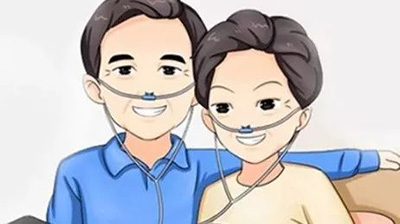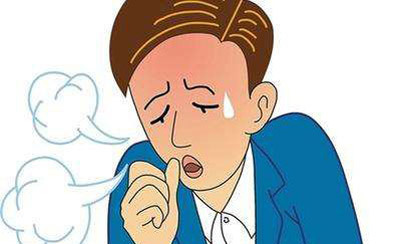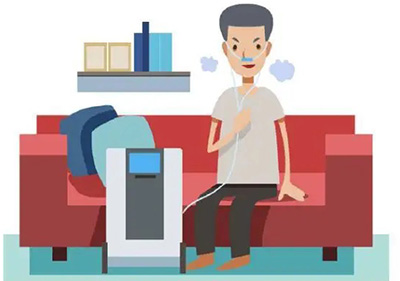01 Apr 2022
Oxygen is one of the essential substances to sustain life, and human life cannot be lived without inhaling oxygen in the air. Inhaled oxygen is transported to the tissues of the body through the capillaries of the lungs by the hemoglobin in the red blood cells to maintain the oxygen supply to the tissues. Oxygen deficiency occurs when the heart, lungs, blood and other pathologies occur and oxygen therapy with the oxygen concentrator is required. In clinical practice, hypoxic diseases caused by chronic lung diseases, such as COPD and interstitial lung disease (ILD), are more common. Oxygen therapy has been listed as one of the necessary treatments for hypoxic diseases by WHO. Home oxygen therapy with the oxygen concentrator can reduce the number of hospitalizations and prevent disease exacerbation, thus the therapeutic effect of oxygen therapy is irreplaceable by any drug therapy.

Goals and modalities of home oxygen therapy for chronic lung disease
The purpose of home oxygen therapy with the oxygen concentrator is to correct hypoxemia, improve quality of life, increase exercise tolerance, reduce acute exacerbations of hypoxic diseases and hospitalization frequency, and reduce mortality. There are various modalities of home oxygen therapy with the oxygen concentrator, including long-term oxygen therapy (LTOT), nocturnal oxygen therapy (NOT), ambulatory oxygen therapy (AOT), palliative oxygen therapy (POT) and short-burst oxygen therapy (SBOT).
Indications for various home oxygen therapy modalities
Experts recommend long-term home oxygen therapy (not less than 15 h/d) for patients with COPD with severe hypoxemia. Severe hypoxemia is defined as the following when inhaling room air at standard atmospheric pressure:
1. arterial partial pressure of oxygen (pa02) ≤ 55 mmHg (7.3 kPa, 1 mmHg = 0.133 kPa), or oxygen saturation (Sp02) ≤ 88% as measured by noninvasive pulse oximetry;
2. pa02 in the range of 56~59 mmHg (7.5~7.9 kPa) or Sp02=89%, accompanied by hematocrit ≥55%, peripheral edema, and one of the three conditions of pulmonary P waves on ECG.Patients with COPD with moderate hypoxemia (Sp02 in the range of 89% to 93%) are not recommended for LTOT. Chronic hypoxia due to COPD should be treated with oxygen therapy if the patient has pa02 <50 mmHg (6. 7 kPa) with elevated paCO2. LTOT (no less than 15 h/d) is recommended for patients with ILD who have severe hypoxemia while inhaling air indoors.

Nocturnal oxygen therapy (NOT) with the oxygen concentrator is performed only during nighttime sleep and is indicated for patients who develop hypoxemia during sleep. NOT is recommended for patients with chronic lung disease associated with nocturnal Sp02≤88% hypoxemia. For patients with obstructive sleep apnea syndrome and obesity hypoventilation syndrome combined with respiratory failure, in addition to conventional NOT, non-invasive ventilation support therapy should be considered at the same time.
Ambulatory Oxygen Therapy (AOT) with the oxygen concentrator refers to the delivery of oxygen via a portable oxygen device during exercise and daily activities for patients who are not hypoxemic at rest, but whose Sp02 decreases after activity. AOT is recommended for patients with chronic lung disease requiring continuous oxygen supply >3 L/min for outdoor activities, or for use of small portable oxygen concentrators. AOT is recommended for patients with COPD and ILD with severe exertional hypoxemia.
Short-burst oxygen therapy (SBOT) with the oxygen concentrator refers to a short period (10-20 min) of intermittent oxygen therapy, often before and after exercise. Some studies have shown that SBOT does not improve exercise endurance or prognosis and is not recommended. Palliative oxygen therapy (POT) patients with ILD who have severe respiratory distress may be considered for POT.

For COPD with hypercapnic respiratory failure, controlled oxygen therapy or continuous low-flow oxygen with the oxygen concentrator should be given with a target Sp02 range of 88% to 92% to prevent the continued increase in PaCO2 caused by excessive oxygen therapy. For patients with COPD without hypercapnic respiratory failure, non-controlled oxygen therapy with the oxygen concentrator can be used, and the recommended target Sp02 range for oxygen therapy with the oxygen concentrator is 94%-98%. For some patients with recurrent COPD with hypercapnic respiratory failure, it is recommended to refer to the patient's previous blood gas analysis report during the acute exacerbation to guide the choice of oxygen therapy with the oxygen concentrator. For patients with previous hypercapnia, oxygen should be administered first by nasal cannula (oxygen flow rate range 1~3 L/min) to maintain Sp02 at 88%~92%. If Sp02>92%, FiO2 should be lowered; if Sp02<88%, FiO2 should be adjusted upward.

Daily continuous oxygen therapy with the oxygen concentrator is recommended. For patients with stable COPD with paO2 ≤ 55 mm Hg at rest, or with paO2 in the range of 56-59 mm Hg with pulmonary heart disease, erythrocytosis or pulmonary hypertension, the duration of daily oxygen therapy with the oxygen concentrator should be at least 15 h. Patients with COPD need to pay attention to changes in paCO2 during long-term oxygen therapy, and arterial blood gas analysis should be performed after each adjustment of oxygen flow. Arterial blood gas analysis should be performed after each oxygen flow adjustment to determine whether paCO2 is elevated. In case of respiratory acidosis or paCO2 >50 mmHg, further investigations should be performed to determine the cause.
Long-term oxygen therapy with the oxygen concentrator is recommended for ILD patients with chronic hypoxemia to improve the patient's hypoxic status. For patients with ILD who breathe room air at rest with paO2 ≤ 55 mmHg, or Sp02 ≤ 88%; at rest with paO2 ≤ 60 mmHg (8.0 kPa); with peripheral edema, erythrocytosis (hematocrit ≥ 55%) or combined with pulmonary hypertension, the recommended duration of daily oxygen therapy with the oxygen concentrator is at least 15 h.
AOT is recommended for patients with ILD who have severe exertional hypoxemia while breathing room air, which is a characteristic of ILD and is usually more severe in patients with ILD than in those with COPD.
Keywords: oxygen concentrator
Originally published 01 Apr 2022, updated 01 Apr 2022.